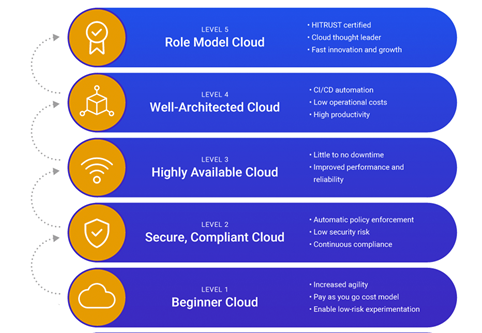Developing a Cloud Maturity Model (CMM) for mapping an organization’s journey to hybrid or cloud-first IT modernization has been a best practice for nearly a decade. The standard model generally seeks to outline the acceleration of IT efficiency and capability in the service of business objectives. It makes good sense.
A CMM progresses toward maturity from an initial ad hoc (or nonexistent) implementation to a structure that’s cost-effective and repeatable, then well-defined and systematic, then quantitatively managed and measured, before finally achieving complete cloud optimization. Traditionally, this process was a time-consuming and labor-intensive journey, and it may have taken years to come to fruition.
But I propose that what a CMM should look like in 2021 is decidedly different than was standard even a year ago. Both the pace of cloud adoption and the pace of the CMM journey have accelerated drastically.
Shift to Cloud-Centric IT
The cloud is now much more than just a data center somewhere else. It is actually a way to enable and accelerate business. Industry today embraces the tremendous amount of value that can be gained from cloud power because of the innovation that it allows.
According to IDG’s 2020 Cloud Computing Survey in June last year, 59% of responding technology buyers said their organizations planned to be mostly or all in the cloud within 18 months, and 38% said they were mostly or all in the cloud already. A whopping 92% reported that their IT was at least “somewhat” cloud-based.
The pandemic-inspired shift to remote work globally likely inspired an accelerated uptick in newly virtualized IT implementations and cloud adoption. As Microsoft CEO Satya Nadella noted last spring, "We've seen two years' worth of digital transformation in two months." These cloud adoption gains may have been reactive, but they changed the landscape. Perspective on what constitutes standard IT operating procedure is different now.
In addition to the pandemic’s extraordinary impact on increased adoption, the evolution of capability has also been escalating at a breakneck pace. One need only look at Amazon’s What‘s New with AWS? page or Microsoft’s Azure Updates page to get an inkling of how quickly advancements roll out — there were dozens of updates to both in just the first month of 2021!
CMM Then and Now
As a result, the average organization's CMM has undergone some changes as well, though some aspects remain fairly stable. After a decade in business as a managed service provider (MSP), I've come to recognize that there's a very predictable adoption pattern with our clients (which are typically organizations in the healthcare space).
Initially, cloud migration is a financial decision. There's generally some inflection point — a colocation or data center lease is ending, or equipment has reached end of life — and the organization has to decide whether to commit to large new capital expenditure or transition to an OpEx model with pay-as-you-go on cloud.
So, the impetus for migration usually starts with total cost of ownership (TCO) analysis. Once we’ve gotten clients up and running and automating on the cloud, we start talking about how to make their applications break less and how to make the infrastructure more secure and more compliant. Progressively, the outcomes that our clients experience become less technical, less financial, and more strategic. And as we move our clients through the cloud maturity model, the types of outcomes that we get to talk about become more compelling.
Here’s a basic CMM diagram for reference:
At the bottom, CMM levels 1–3 address questions such as: Did you save money? Did the application experience less downtime? Are you more secure? Is your encryption better? These are good outcomes. But because we're in the healthcare industry, at the top of the CMM, we get to address questions like: Were you able to serve more COVID-19 patients, and did fewer people die? That's a much more powerful place for a healthcare organization to be.
Reaching those higher levels of CMM exponentially increases an organization’s arsenal of tools and ability to innovate because they can do things on cloud that they never could do in a data center. It rewrites the risk/benefit paradigm for an organization.
Let's say you wanted to run an experiment that maybe only has a 10% chance of succeeding. But if it does succeed, it would be a great new feature. In a traditional data center, it might require $5-million worth of new servers to even run the experiment and months and months of time to do it. If it is probably going to fail anyway, who wants to take that risk? In the cloud, you can spin up a 10,000-CPU supercomputer in minutes, run an experiment for a few hundred bucks, and shut it all down with the push of a button. If it succeeds, wonderful! If it doesn't, you've barely touched your budget — so why not swing for the fences? The ability to experiment with new things, fail fast, and move forward is unparalleled in the cloud.
That’s always been the goal of a CMM. What’s different now is the speed at which companies can get to those higher and more compelling levels of function.
Turbo-Transformation
By way of example, I have a client that runs one of the more successful health information exchanges in the country. Its Chief Information Security Officer (CISO) has what we joke is the worst job in the world — because if a CISO does their job perfectly, the best outcome that they can expect is that absolutely nothing happens, right? But within a matter of months of cloud migration, this CISO was actually able to design a brand new line of revenue, recognizing that their excellent new cloud-based architecture could be deployed by other state health information exchanges. They now sell pre-built health information exchange services to other companies. The organization’s information security department, traditionally pigeonholed as a necessary operating expense, became a new profit center — and they’re experiencing a huge growth surge as a result.
This is a tangible example of what happens at the top of the CMM. It’s what happens when you stop thinking about cloud power as OpEx instead of CapEx and start thinking about it as a way to drive real agility in how you operate as an organization. Technology “gets out of the way.” IT teams stop focusing on servers and firewall rules and network routing tables and subnets and start focusing on new ways to improve the business. It represents the psychological leap away from a resource-constrained mindset.
What’s most strikingly different about the CMM journey today is how quickly that leap takes place. Cloud managed service providers enable low-cost, automated, and highly secure, reliable, and available infrastructures in a veritable blink of an eye — it is practically table stakes at this point. Organizations can now progress to higher tiers of cloud maturity in a matter of days and months as opposed to quarters and years. The question becomes “What can we do next week?” as opposed to “What can we do next year?” That’s what cloud maturity means in 2021.
Gerry Miller is CEO of Cloudticity.










